In order to know which ceiling fan to purchase for your space and how to use a ceiling fan to the best of its ability, you need to understand ceiling fan airflow. For example, it’s all well and good to know that there is a summer mode and a winter mode, but knowing what happens to the airflow in each of these modes helps you to customize the fan’s function to work with your space.
To understand ceiling fan airflow, the basics of what it is as well as the complexities, including seasonal modes of airflow, must be considered in order to maximize it for your benefit.

Ceiling fan airflow is measured in CFM. It is influenced by motor capacity, blade design/number, fan location/clearances, and speed. The blades are often reversible. Summer mode pushes air down and winter mode pulls it up. Airflow direction is determined by which side of the pitched blade leads rotation.
Summer Mode Airflow
Pattern
When your ceiling fan is switched to summer mode, its blades will be turning counterclockwise.
To tell which direction your ceiling fan is turning, stand directly under the fan and look up, preferably while the ceiling fan is at a low speed so you can see the individual fan blades. The direction the blades are moving should be clear from this angle.
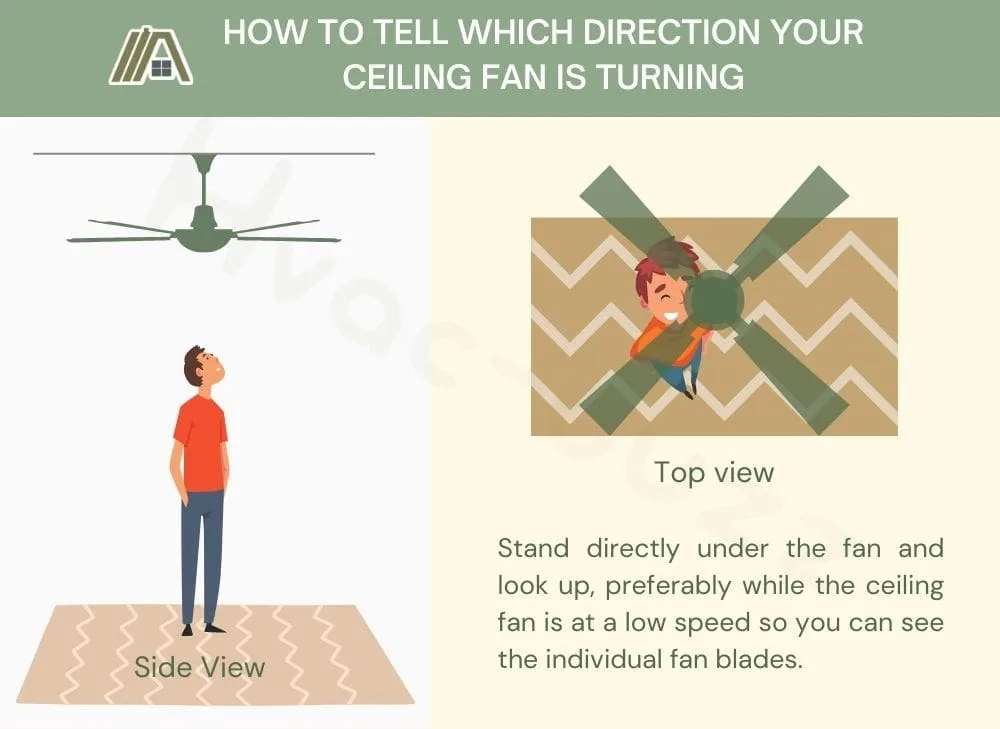
When a ceiling fan turns counterclockwise, the high part of the pitched blades will lead. This pushes air down and creates a downward stream of air.
To understand how this works, hold your hands up so that your palms are facing down and your fingertips are facing each other. Your right hand is the ceiling fan blade and your left hand is the air.
Now, you need to “pitch” your right hand to a 45° angle so that the fingertips of your left hand are now in line with your palm.
Move the ceiling fan blade, a.k.a, your right hand, towards your left hand (the air). When your hands meet, the fingers of your left hand should naturally slide down the palm of your right hand, following the downward direction of your lower arm.
This is how the blades push air into the area below the fan when in summer mode.
So, the air around the fan is pushed down. This also forces the air already below the fan to move closer to the floor. The space around the fan is filled with air from above it and further out to the sides of the fan because of the vacuum created by pushing the air down.
As air is pulled in from the sides of the fan, it creates a vacuum there, which is filled with air from the lower portions of the room, which is how whole room air circulation is achieved with a ceiling fan in summer mode.
Cooling Mechanism and Efficiency
As the air circulates, it creates an even distribution of heat/cold throughout the room.
Warm, less dense air rises to gather at the ceiling, and cold, more dense air sinks to gather at the floor. When the ceiling fan pushes air down, warmer air is displaced from the ceiling and moved downwards.
Although this warm air will initially be felt by the room’s occupants, the warm air will displace the cool air that dwells near the floor.
With both warm and cold air being mixed together constantly and preventing stagnancy, warm and cool spots will be eliminated in the room by your ceiling fan. All of the air will be in circulation at a constant temperature. Overall, the room should feel cooler at this constant temperature.
But this is not the only way that a ceiling fan makes you feel cooler. If it was, I don’t think that ceiling fans would have held onto their place in the cooling business for as well and as long as they have.
The primary cooling mechanism of a ceiling fan in summer mode is the wind chill effect. Wind chill cools the people who occupy the room or, more specifically, those who are in the direct path of the downward airflow.
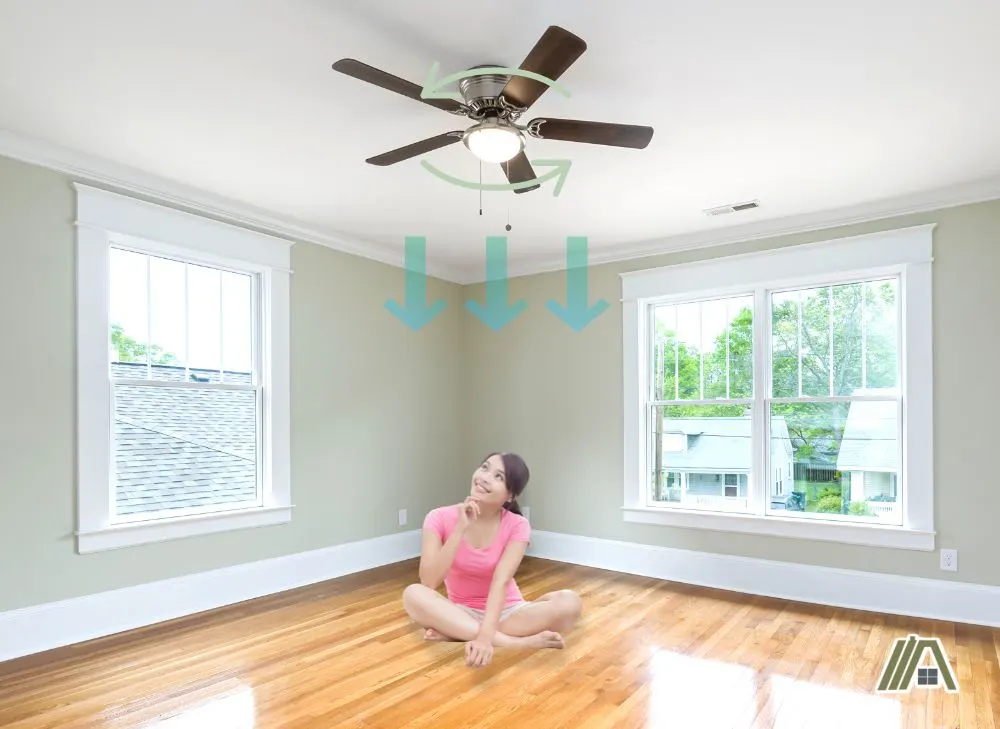
When air is pushed downwards, it actively moves across your skin. This blows away the naturally-forming layer of body heat sitting against your skin, making you feel cooler and allowing more body heat to be released and blown away.
The moving air also increases evaporative cooling if you are sweating.
This effect is noticeable and you will get a significant cooling benefit from a ceiling fan in summer mode.
Although ceiling fans redistribute heat/cold and make you feel cooler with the wind chill effect, they do not actually alter the overall ambient air temperature. This is because they cannot physically remove heat from a room like an AC.
If you pair the ceiling fan in summer mode with an AC, central air, or HVAC system, however, you can make both systems more efficient and effective.
However, depending on the location of the return vents and registers, clockwise direction might actually be best to provide the most effective cooling (although you lose wind chill).
It is in these situations that it pays to understand how the air flows in summer and winter modes.
Winter Mode Airflow
Pattern
For all those out there wondering, ceiling fan direction really does matter, and this is obvious when you look at what reversing the direction of rotation does to the airflow in a room.
In winter mode, the lower part of the pitched blades will lead while the fan is turning. This draws air up toward the ceiling.
To understand this, hold your hands like you did previously, but this time, you tilt the fingertips of your right hand down at a 45° angle.
When you move your right hand towards your left hand, your left hand should be forced upward. This is what happens to the air with a clockwise-rotating ceiling fan.
Colder air from lower portions of the room is pulled out of the occupied space and forced into the space between the fan and the ceiling, where warm air has gathered. This warm air is thus displaced and moves out from the ceiling fan.
The vacuum created by pulling up air from under the fan is eliminated as air from the lower side portions of the room is pulled into the area below the fan. This, in turn, pulls air down from the upper side portions of the room, where the displaced warm air now is.
This is how the warm air is pulled into the occupied space.
Heating Mechanism and Efficiency
Now, as it was presented above, you may think that this is a good heating system. The cold air is pulled away and replaced with warm air.
However, just like in summer mode, the ultimate result of this movement of air is that the two “extreme” temperatures mix together until they are more evenly distributed throughout the room. The room may feel a little warmer but the overall ambient temperature has not changed.
So, is there a wind chill equivalent that can make the ceiling fan in winter mode more effective? Unfortunately, the answer is no. But don’t write off the winter mode just yet!
With the simple addition of a space heater, radiator, or another heating device, you can make the ceiling fan and the heating device more efficient and effective when the fan rotates in winter mode.
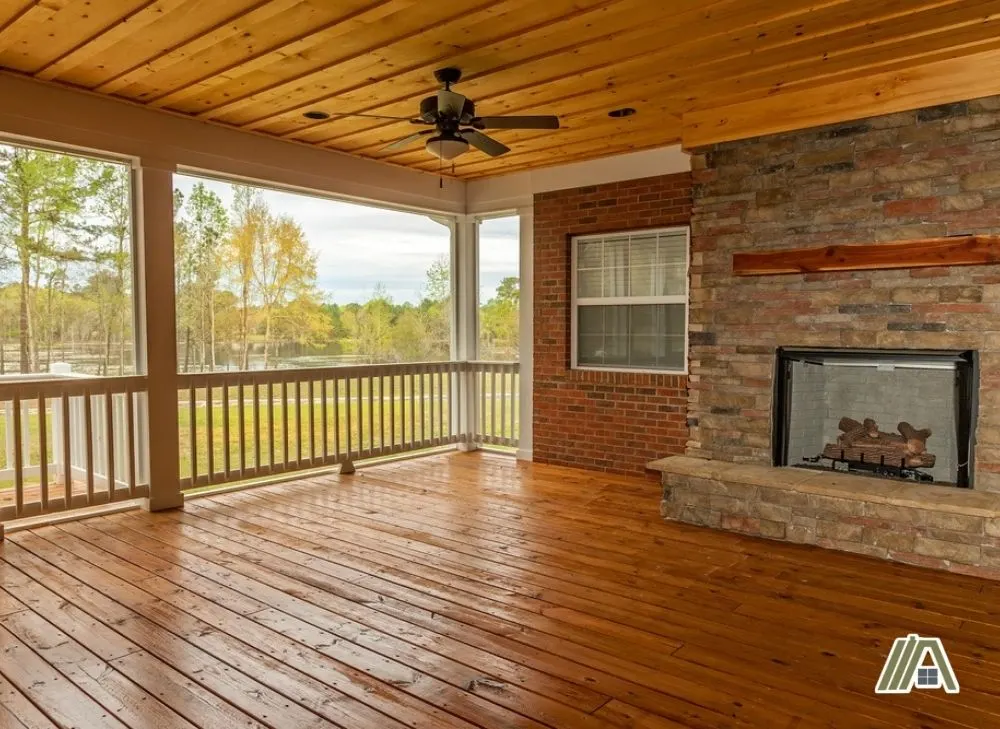
It can also be used with your HVAC system, although, in some cases, counterclockwise rotation on low speed with better help to heat the room. It all depends on where your return vents and registers are located.
Ceiling Fan Airflow Measured in CFM
When people talk about the capacity of a ceiling fan (and other fans as well), they speak about how many cubic feet of air the fan can move each minute. This is shortened to CFMs.
In order to know the ideal CFM rating that your ceiling fan should have, you must know the dimensions of your room. If you don’t, get a tape measure and measure the dimensions of your room.
Multiply the height, width, and length to get the volume of the room. Then match this to the CFM rating.
The recommended CFM goes up in increments of 1,000 CFM for each added 100 square feet (length x width).
Good ceiling fan CFM ranges from 4,000 to 5,000 CFM. Above this CFM rating would be excellent CFM.
Factors That Influence Ceiling Fan Airflow
Motor Capacity
Ceiling fan motor capacity is a large determinant of the fan’s CFM rating. In order to rotate the fan blades and move the air, the ceiling fan has to exert enough power to overcome inertia and maintain a constant speed, and do so without overheating.
In general, increasing ceiling fan motor capacity increases the volume of air moved per unit time and increases the speed at which this air is pushed down or pulled up.
As far as efficiency goes, a higher motor capacity means greater efficiency.
This is because the larger a motor gets, the more room there is to make the power-creating process as efficient as possible. This is not as possible in small motors.
Blade Design and Number
The ability and efficiency of a ceiling fan in generating airflow are dependent on so many interlinking factors that it is very difficult to provide a definitive relationship between blade design and number and CFM/efficiency.
However, we can make certain generalized statements with caveats:
- Larger blades (longer) will move more air due to the increased surface area, provided the motor is strong enough to power the rotation to make the system effective. The shape (including the width) and pitch of the blade must also provide the ideal balance between airflow production and drag to make the system efficient.
You can read more in Bigger Fan Blades: Will They Move More Air?
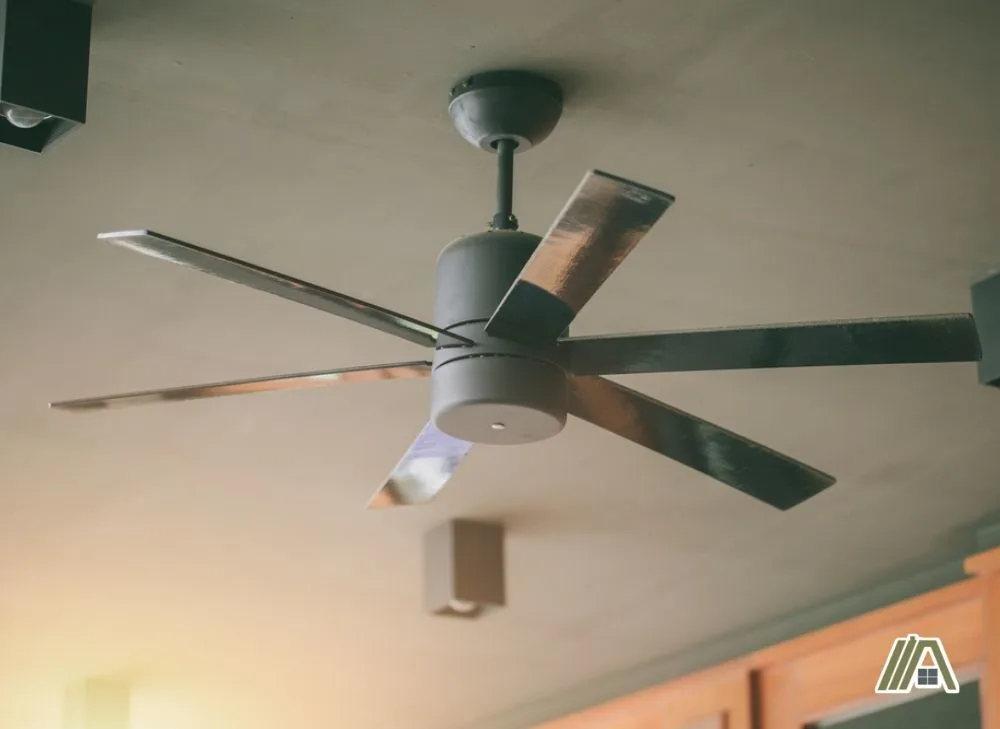
- More blades make a ceiling fan more effective because of the greater surface area pushing air around. However, the motor has to be strong enough to power these blades and make the system effective. The blade design and pitch must also balance increased surface area with resistance to make it efficient.
You can read more in Ceiling Fan: Are More Blades Better? (Cooler, More Efficient, Quieter).
- The greater the pitch of the blade, the more air it can move, making it effective. However, there is a point where the resistance created exceeds the power of the motor, so to ensure continued effectiveness and efficiency, the pitch needs to be around 10-15°.
You can read more in Ceiling Fan Blade Pitch Explained.
- Paddle-shaped blades that are wider at the end and narrower where they attach to the fan are more effective and efficient as long as the paddle portion is not too wide (which would increase drag dramatically).
You can read more in Most Efficient Ceiling Fan Blade Design (Highest CFM per Watt).
Speed Setting
As you may observe when you operate a ceiling fan in your home, when you increase the speed setting of your ceiling fan, you will experience more airflow.
This is because the faster the blades move, the more rotations there are per minute. If each rotation moves x amount of air, the more rotations, the more air is moved in the minute. This equates to a greater CFM.
Your fan can be effective at all speeds, but it will be more effective at higher speeds.
In terms of efficiency, higher speeds tend to use more power, so the efficiency (amount of power used to power a rotation) might be reduced.
Fan Location/Clearances
Walls, ceilings, floors, and objects create obstructions to ceiling fan airflow, either completely blocking it off or causing the airflow to become turbulent and less efficient.
There are minimum clearance distances that a ceiling fan should adhere to in order to be most effective and efficient.
In addition, the air further away from the ceiling fan will be less affected by the moving blades, so you need it closer to people or the predominantly occupied spaces. This is typically in the middle of the room.
To put a ceiling fan in the corner of the room, for example, would increase airflow turbulence. More energy is lost to non-laminar flow and the air won’t move as well in any direction. And the areas on the other side of the room to the fan will not feel the effects of air movement.
To put a ceiling fan too high would mean that the downward flow of air has slowed down too much by the time it reaches the occupants to have any significant effects.
Increasing Airflow Efficiency of Ceiling Fans
- Purchase a ceiling fan with a relatively high motor capacity.
- Make sure all the aspects of blade design and number balance each other out.
- Use a moderate speed setting to balance effectiveness and efficiency.
- Install the fan at least 8″ from the ceiling, at least 18″ from the walls or tall objects, and about 9′ from the floor.
- Place it centrally and away from cluttering furniture.
- Install the fan properly.
- Maintain the fan in good and clean condition.
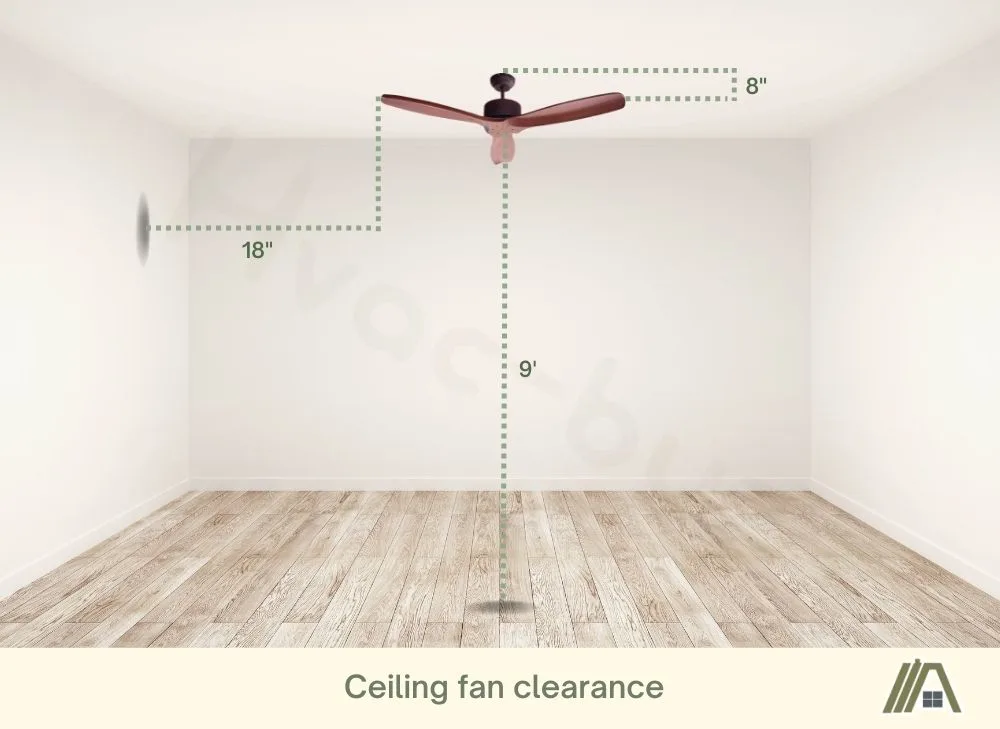
You can read more in Simple Tips to Improve Ceiling Fan Airflow.
Sources
https://www.todaysfans.com/blogs/blog/what-is-cfm-in-a-ceiling-fan
https://www.lumens.com/the-edit/the-guides/how-to-choose-a-ceiling-fan/
https://www.hunterfan.com/blogs/hunter-blog/understanding-ceiling-fan-airflow

